
Quick Tips
- Clean gold jewelry.
- Clean white gold jewelry.
- Clean silver jewelry.
- Clean platinum jewelry.
- Clean copper jewelry.
- Clean tungsten and titanium jewelry.
Some people want to clean jewellery. Other people want to clean jewlery. Still more people want to clean jewelery. I personally prefer to clean jewelry. I’m not trying to be a dick. I just think it’s amusing that a word that can be so hard to pronounce can be even harder to spell. In fact, I once got booted from a spelling bee because of that friggin’ word. Not that I was in any real danger of winning, but it still stung. Anyway, the important thing is you’ve got some dirty jewelry and you need to know how to clean it. Luckily, my early childhood experience with misspellings did not hinder my ability to learn how to clean jewelry.
The problem with cleaning jewelry is that there are so many different types and they’re made with a wide variety of different metals and stones. The same methods that work to clean jewelry of one type are not always the same methods used to clean another. And yes, as you will see, oftentimes the methods are quite similar. You will also notice, however, that there are some subtle, and often important, differences. This article is an overview for cleaning various types of jewelry. It contains brief descriptions for cleaning different types of jewelry and page links that lead you to more in-depth articles on those particular subjects. It is a work in progress. If the particular “in-depth” article that you’re looking for is not yet available, keep your shirt on. We’ll get to it soon.
Basics for Cleaning Jewelry
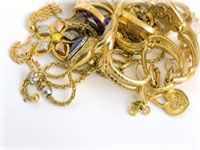 Clean gold jewelry. Since gold is such a soft metal, it is very important to be extremely careful with it so as not to scratch it up. Luckily, there is a very gentle and effective method for cleaning gold. All you need do is to fill a bowl with warm water, mix in a little gentle dish soap, let it soak for awhile, give it a gentle scrubbing, and dry it. For in-depth instructions on this gold-cleaning method, click on the link at the beginning of this paragraph.
Clean gold jewelry. Since gold is such a soft metal, it is very important to be extremely careful with it so as not to scratch it up. Luckily, there is a very gentle and effective method for cleaning gold. All you need do is to fill a bowl with warm water, mix in a little gentle dish soap, let it soak for awhile, give it a gentle scrubbing, and dry it. For in-depth instructions on this gold-cleaning method, click on the link at the beginning of this paragraph.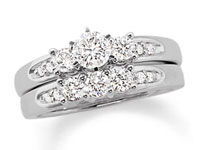 Clean white gold jewelry. Cleaning white gold jewelry is just as easy as, and almost identical to, cleaning yellow gold. You do, however, need to be a little more careful. White gold is not truly white. It is a very pale yellow. To cover this pale yellow, white gold rings are plated with a very thin layer of a shiny metal called rhodium. Since it is such a thin layer, you need to be very careful so as not to scratch or rub it off. For a full article on the subject, click the link at the beginning of this paragraph.
Clean white gold jewelry. Cleaning white gold jewelry is just as easy as, and almost identical to, cleaning yellow gold. You do, however, need to be a little more careful. White gold is not truly white. It is a very pale yellow. To cover this pale yellow, white gold rings are plated with a very thin layer of a shiny metal called rhodium. Since it is such a thin layer, you need to be very careful so as not to scratch or rub it off. For a full article on the subject, click the link at the beginning of this paragraph.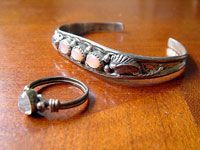 Clean silver jewelry. Since almost all silver jewelry is actually made from sterling silver, this section will focus on how to clean sterling silver. The difference between the two is that while silver is almost totally pure (> 99%), sterling silver is only about 92.5% silver. The remaining 7.5% is usually comprised primarily of copper. Cleaning silver jewelry, while not as simple as cleaning gold jewelry, is still pretty darn simple. Start with a quick wash with a gentle detergent and water. Next, line a pan with aluminum foil, add a little water and baking soda, bring it to a boil, and gently place your silver in the pot. After a brief time in the pot, remove, rinse, and dry. For all the specifics, click on the first sentence of this paragraph.
Clean silver jewelry. Since almost all silver jewelry is actually made from sterling silver, this section will focus on how to clean sterling silver. The difference between the two is that while silver is almost totally pure (> 99%), sterling silver is only about 92.5% silver. The remaining 7.5% is usually comprised primarily of copper. Cleaning silver jewelry, while not as simple as cleaning gold jewelry, is still pretty darn simple. Start with a quick wash with a gentle detergent and water. Next, line a pan with aluminum foil, add a little water and baking soda, bring it to a boil, and gently place your silver in the pot. After a brief time in the pot, remove, rinse, and dry. For all the specifics, click on the first sentence of this paragraph.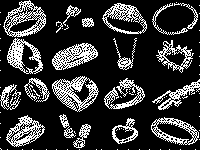 Clean platinum jewelry. To clean jewelry that is made of platinum, all you need to do is fill a bowl with hot water, add some mild dish detergent like Seventh Generation, and give it a good soak. Allow your platinum jewelry to sit in the water/detergent solution for about ten minutes, remove it, and wipe it down with a soft cloth. Then rinse it and dry it. If after this treatment your platinum jewelry still looks dull, you should probably take it in to a jeweler to be professionally polished. The dullness is caused by minute dents and scratches. A jeweler can easily polish these out and restore its shine.
Clean platinum jewelry. To clean jewelry that is made of platinum, all you need to do is fill a bowl with hot water, add some mild dish detergent like Seventh Generation, and give it a good soak. Allow your platinum jewelry to sit in the water/detergent solution for about ten minutes, remove it, and wipe it down with a soft cloth. Then rinse it and dry it. If after this treatment your platinum jewelry still looks dull, you should probably take it in to a jeweler to be professionally polished. The dullness is caused by minute dents and scratches. A jeweler can easily polish these out and restore its shine.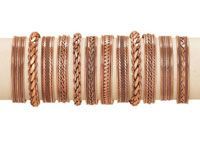 Clean copper jewelry. Since copper has a tendency to tarnish faster than other metals, it will need to be cleaned more often. Happily, cleaning copper jewelry can be done quickly and easily from home. Start by filling a bowl with just enough straight white vinegar to cover the jewelry and stir in about a teaspoon of salt. Once the salt is totally dissolved, place the jewelry in the bowl and let it soak for five minutes. After the five minutes, take the jewelry out, examine it, and repeat if necessary. Often the soak will be enough to clean copper jewelry. If not, make a paste of water and baking soda and gently rub it into the metal with your fingers. Then rinse it off and dry it with a soft cloth.
Clean copper jewelry. Since copper has a tendency to tarnish faster than other metals, it will need to be cleaned more often. Happily, cleaning copper jewelry can be done quickly and easily from home. Start by filling a bowl with just enough straight white vinegar to cover the jewelry and stir in about a teaspoon of salt. Once the salt is totally dissolved, place the jewelry in the bowl and let it soak for five minutes. After the five minutes, take the jewelry out, examine it, and repeat if necessary. Often the soak will be enough to clean copper jewelry. If not, make a paste of water and baking soda and gently rub it into the metal with your fingers. Then rinse it off and dry it with a soft cloth.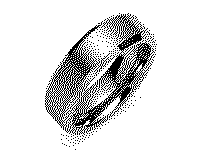 Clean tungsten and titanium jewelry. This is probably the only section of this part of the article that doesn’t deserve or require any more explanation than what I can fit into a single paragraph. In fact, I’ll probably have a difficult time stretching this into a whole paragraph. Oh! Check this out. At this very moment I’m making it longer. Pretty sneaky, eh? Anyway, the only things that are required for cleaning titanium and tungsten are warm soapy water and a rag. For really severe cases like, say, tar or dried-on boogers, you might need to use a soft toothbrush dipped in warm soapy water. Just rinse the jewelry with fresh water when you’re done and dry it off with a soft towel.
Clean tungsten and titanium jewelry. This is probably the only section of this part of the article that doesn’t deserve or require any more explanation than what I can fit into a single paragraph. In fact, I’ll probably have a difficult time stretching this into a whole paragraph. Oh! Check this out. At this very moment I’m making it longer. Pretty sneaky, eh? Anyway, the only things that are required for cleaning titanium and tungsten are warm soapy water and a rag. For really severe cases like, say, tar or dried-on boogers, you might need to use a soft toothbrush dipped in warm soapy water. Just rinse the jewelry with fresh water when you’re done and dry it off with a soft towel.
Care in Cleaning Jewelry with Gemstones
When cleaning a piece of jewelry that contains gemstones, greater care needs to be taken. Make certain to always check the settings and prongs. If the gemstone is at all loose, take it into a jeweler. The last thing you want is to lose gemstones, pearls, or, even worse, diamonds. It is also important to keep in mind that while many people suggest soaking jewelry in ammonia and water, ammonia has the potential to discolor, pit, or otherwise damage gemstones. This is especially true of soft or organic gemstones such as opal or pearl, and of gemstones that are color treated, coated, or fracture filled. With this in mind, it’s always a good idea, when cleaning jewelry for the first time, to take it into a jeweler and ask them if your gemstones can be safely cleaned with ammonia or if you should simply wash them with mild dish detergent and water.
Naturally Clean Jewelry at Home
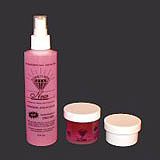 Something New Professional Jewelry Cleaner.This jewelry cleaner is made from 100% biodegradable cleaning substances, is all natural, and is safe for cleaning pretty much any type of precious metal. Aside from the metals, it is also safe for use on soft stones such as pearls, opals, turquoise, jade, and more.
Something New Professional Jewelry Cleaner.This jewelry cleaner is made from 100% biodegradable cleaning substances, is all natural, and is safe for cleaning pretty much any type of precious metal. Aside from the metals, it is also safe for use on soft stones such as pearls, opals, turquoise, jade, and more.
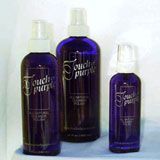 Touch of Purple All Natural Cleaner Polish.This amazing jewelry cleaner is safe for cleaning metals such as gold, silver, platinum, brass, stainless steel, and many others. It is also safe for use on all sorts of gems like diamonds, opals, pearls, emeralds, rubies, turquoise, amethyst, etc. On the off chance that you care, it’s even safe for use on glass and plexiglass. You can get Touch of Purple in various options, like spray, from Amazon.
Touch of Purple All Natural Cleaner Polish.This amazing jewelry cleaner is safe for cleaning metals such as gold, silver, platinum, brass, stainless steel, and many others. It is also safe for use on all sorts of gems like diamonds, opals, pearls, emeralds, rubies, turquoise, amethyst, etc. On the off chance that you care, it’s even safe for use on glass and plexiglass. You can get Touch of Purple in various options, like spray, from Amazon.
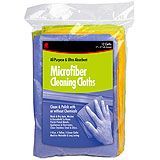 Microfiber cloths. Because many products marketed as jewelry cleaning cloths contain chemicals to help in the polishing process, I recommend using a simple microfiber cloth as an effective alternative. A microfiber jewelry cleaning cloth will work well for removing grease, oils, and dirt from your jewelry, making it look shiny and elegant once more.
Microfiber cloths. Because many products marketed as jewelry cleaning cloths contain chemicals to help in the polishing process, I recommend using a simple microfiber cloth as an effective alternative. A microfiber jewelry cleaning cloth will work well for removing grease, oils, and dirt from your jewelry, making it look shiny and elegant once more.